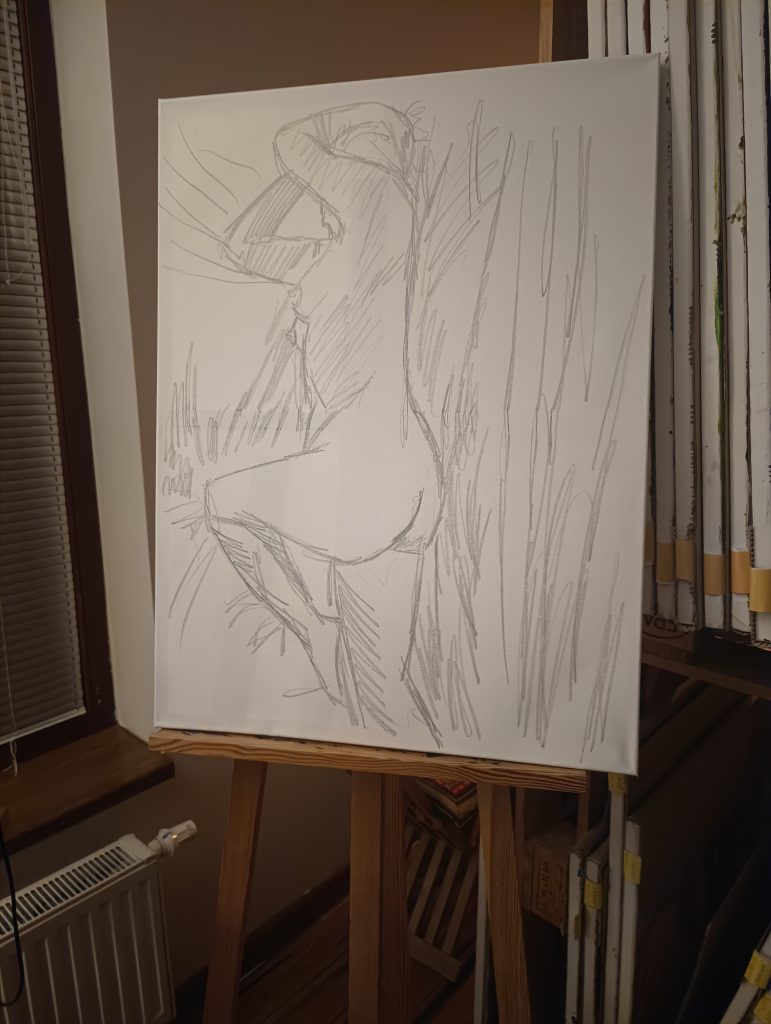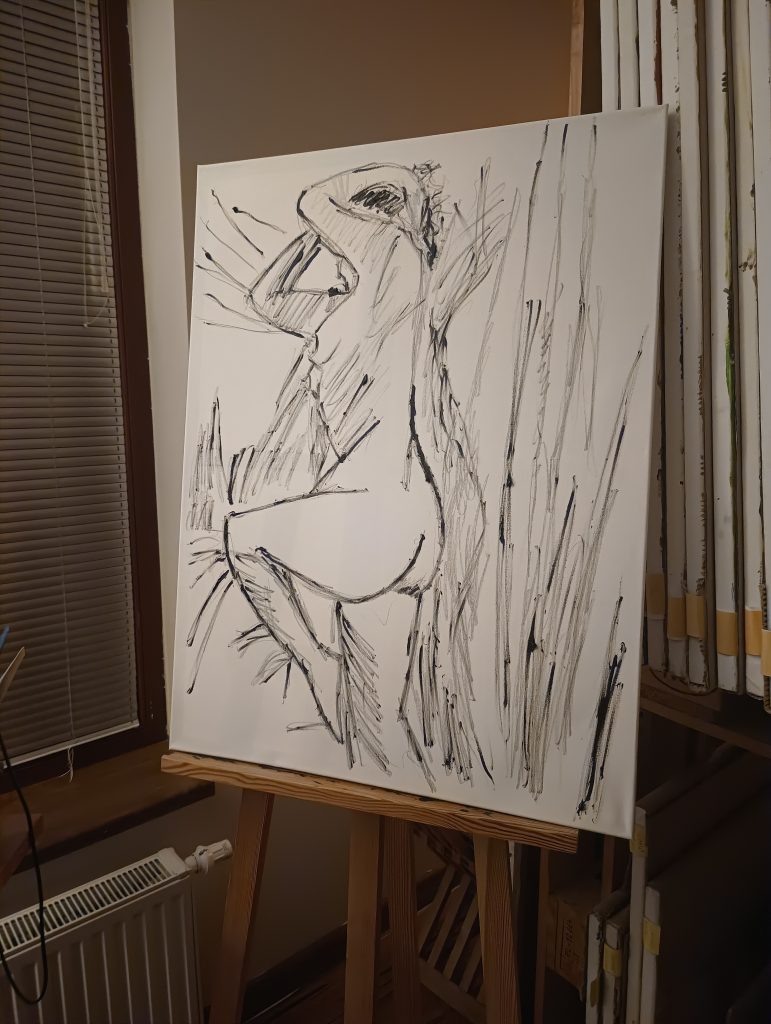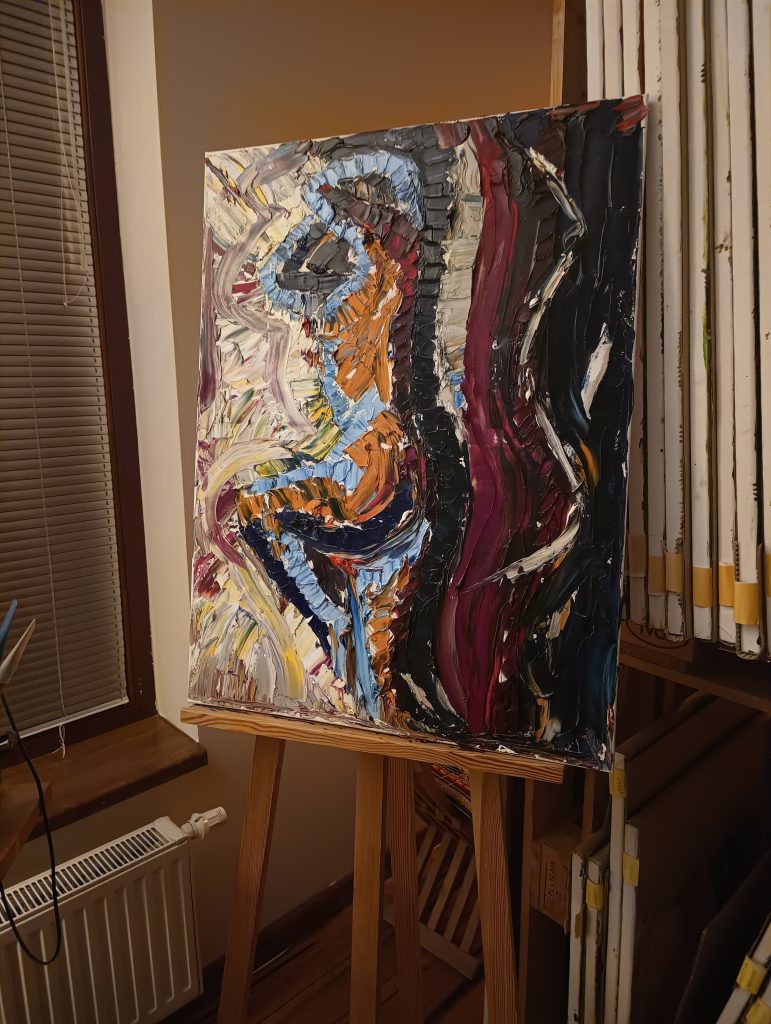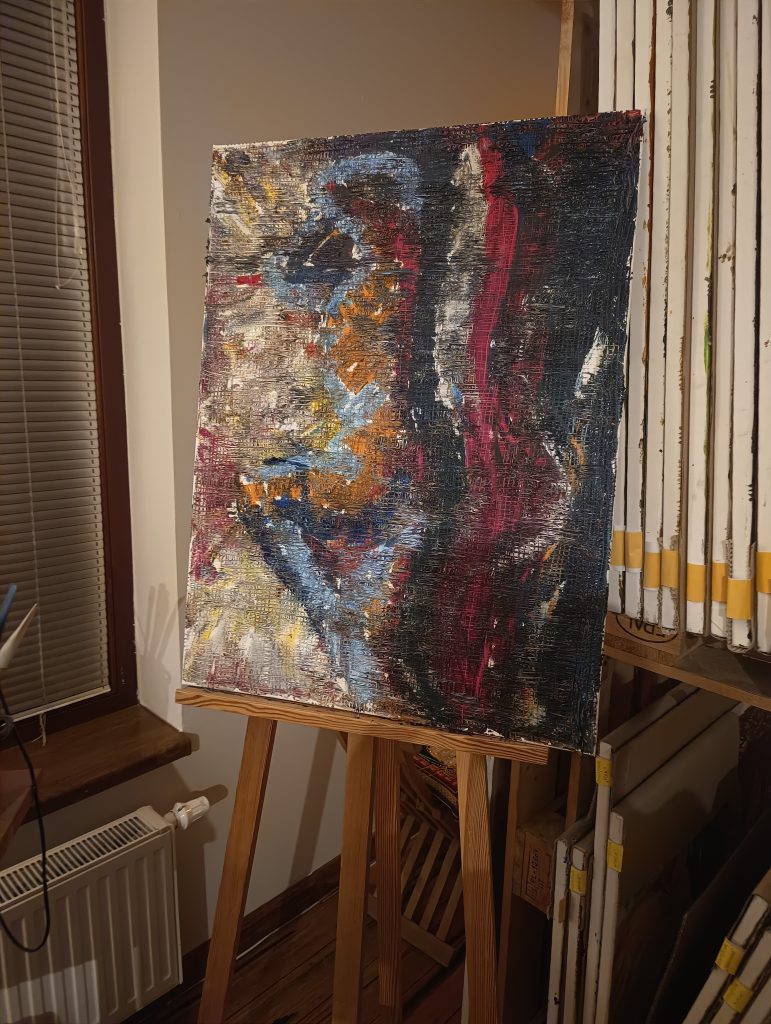NAGOŚĆ w Orapizmie
I. Szkic — faza ego
(świat formy, kontrola, intencja)
Szkic jest dziełem umysłu, który wciąż wierzy, że potrafi uchwycić doskonałość.
To ruch kontroli – nie przepływu.
Linia oddziela, definiuje, ustanawia granice: „tu ja”, „tam ciało drugiego”.
W szkicu artysta jeszcze wierzy, że może posiąść piękno. Nawet, jeżeli szkic ciała ukochanej to świadectwo wspomnienia chwili,
gdy dwoje oddychało jednym rytmem życia w akcie połączenia, to na płótnie jest on po prostu śladem tego zachwytu – harmonią, która została uchwycona w ramy konceptu ego.
Ciało jest tu przedmiotem, nie przestrzenią.
To świat przed pęknięciem –
świat, który zaraz zostanie zniszczony.
II. Kolor — faza świata
(rozpad formy, bunt materii, ból ego)
Farba wdziera się w doskonały szkic.
Rozlewa się po liniach, które miały być wieczne.
Zmazuje, rozmywa, brudzi.
Ego drży – nie wie, czy to profanacja, czy objawienie.
Pamięć o pięknym szkicu staje się raną.
Farba zamienia geometrię w chaos, dumę w rozpacz, wstyd.
To świat binarny w całej pełni –
duma i wstyd, ból i zachwyt, destrukcja i narodziny, światło i cień.
Każda barwa jest krzykiem materii,
która domaga się, by być częścią stworzenia.
Orapista czuje po raz pierwszy,
że jego własny obraz o sobie musi umrzeć.
Nie ma już powrotu do czystej linii.
Nie ma powrotu do szkicu.
Kolor wypala złudzenie panowania.
Otwiera ranę, przez którą może wejść obecność.
III. Rysy — faza Inacji
(przepalenie formy, przekroczenie kreski, zjednoczenie w działaniu)
W miłosnym splątaniu – jeśli jest prawdziwie świadome – energia dwóch ciał przestaje być wymianą.
Staje się krążeniem jednej fali w dwóch formach.
W tym momencie kończą się granice dialogu,
a zaczyna Inacja – stan, w którym ruch i obecność są jednym.
Nie ma już „ona” i „ja” –
jest pole wspólnego istnienia,
gdzie miłość nie potrzebuje formy, by być.
Ciała stają się przejrzyste dla siebie,
a każdy gest – śladem Jedni.
Tu nie chodzi o biologię – lecz o przemianę energii w obecność.
Zmysłowość nie znika – intensyfikuje się, aż przekracza samą siebie.
To moment, gdy doznania stają się tak pełne, że przestają dzielić.
Nie gasną – przepalają granicę między czuciem a świadomością.
Orapista przekracza kreskę – dosłownie i wewnętrznie.
Ręka nie rysuje już, lecz drży.
Gest staje się samym światłem.
Ciało nie uspokaja się – rozświetla się od środka.
IV. Cisza — faza Jaźni
(drapanie, zatarcie, spełnienie przez połączenie, rozpuszczenie ruchu pomiędzy)
Dawne drogi zjednoczenia kończyły się tam,
gdzie pozostawało jeszcze „dwoje”.
Inacja otwiera dalszy wymiar.
To nie akt erotyczny ani mistyczny –
lecz zapis chwili, w której duch i materia przestają być rozdzielne.
To nie wznoszenie się ponad ciało,
lecz rozpoznanie, że ciało już jest światłem.
Nie chodzi o „więcej” – chodzi o rozpuszczenie ruchu pomiędzy.
W Inacji nie ma „przekraczania” ku transcendencji.
Transcendencja wydarza się w samym doświadczeniu.
Orapista przebywa w poszerzonej świadomości.
I wtedy –
koniec szpachli drapie powierzchnię.
Nie po to, by zniszczyć, lecz by uwolnić.
Ostatni gest wymazuje malarza.
Obraz zaczyna oddychać sam.
Bycie staje się widzialne.
Zmysłowość staje się drogą uświęcenia,
a cisza – dowodem, że pełnia już się wydarzyła.
„Nagość nie jest końcem wstydu. Jest początkiem prawdy.”
NUDITY in Orapism
I. Sketch — the phase of ego
(the world of form, control, intention)
The sketch is the work of a mind that still believes it can capture perfection.
It is an act of control — not of flow.
A line that separates, defines, establishes boundaries:
“here I am,” “there — the body of the other.”
In the sketch, the artist still believes he can possess beauty.
Even if the sketch of the beloved’s body is a testimony,
a memory of the moment when two breathed with one rhythm of life in an act of union,
on the canvas it remains only the trace of that admiration —
a harmony held within the frame of the ego’s concept.
Here, the body is an object, not a space.
It is the world before the fracture —
a world about to be destroyed.
II. Colour — the phase of the world
(the collapse of form, the rebellion of matter, the pain of ego)
Paint breaks into the perfect sketch.
It spreads across the lines that were meant to be eternal.
It blurs, erases, stains.
Ego trembles — unsure whether this is desecration or revelation.
The memory of the beautiful sketch becomes a wound.
Paint turns geometry into chaos, pride into despair — and into shame.
This is the binary world in its fullness —
pride and shame, pain and wonder, destruction and birth, light and shadow.
Each colour is a cry of matter
demanding to take part in creation.
For the first time, the Orapist feels
that his image of himself must die.
There is no way back to the pure line.
No return to the sketch.
Colour burns away the illusion of mastery.
It opens the wound through which presence may enter.
III. Traces — the phase of Ination
(the burning of form, the crossing of the line, unity in action)
In love entanglement – if it is truly conscious – the energy of the two bodies ceases to be an exchange.
It becomes the circulation of a single wave through two forms.
At this point, dialogue ends,
and Ination begins —
the state in which movement and presence are one.
There is no longer “she” and “I” —
only a shared field of being,
where love no longer needs form to exist.
Bodies become transparent to one another,
and every gesture is a trace of unity.
It is not about biology,
but about the transformation of energy into presence.
Sensuality does not fade — it intensifies until it transcends itself.
It is the moment when experience becomes so full
that it no longer divides.
It does not extinguish — it burns through the boundary
between sensation and awareness.
The Orapist crosses the line — literally and inwardly.
The hand no longer draws — it trembles.
The gesture becomes light itself.
The body does not calm — it radiates from within.
IV. Silence — the phase of the Self
(scraping, erasure, fulfilment through union, dissolving the movement between)
The old paths of union ended
where “two” still remained.
Ination opens a further dimension.
It is not an erotic act, nor a mystical one —
but the record of a moment
when spirit and matter cease to be divided.
It is not an ascent above the body,
but the recognition that the body is already light.
It is not about “more” —
it is about the dissolving of movement between.
In Ination, there is no reaching toward transcendence.
Transcendence happens within the experience itself.
The Orapist abides in expanded awareness.
And then —
blade of spatula scratches the surface.
Not to destroy, but to release.
The final gesture erases the painter.
The painting begins to breathe on its own.
Being becomes visible.
Sensuality becomes a path of sanctification,
and silence — the proof that wholeness has already occurred.
“Nudity is not the end of shame.
It is the beginning of truth.”



